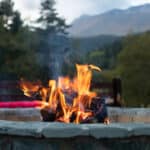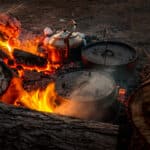Getting ready for natural disasters starts with understanding that different areas face unique threats. This article covers how to start prepping based on where you live. Knowing the specific risks of your region is key since climate change affects each area differently.
We’ll walk through essential steps like making an emergency plan and packing a kit with food, water, and more to last at least three days. You’ll also learn about setting up family communication plans and practicing safety drills.
Plus, we emphasize checking your insurance to make sure it’s up-to-date and covers everything needed for your home’s value and flood risk.
Taking pictures or videos of what you own helps with insurance later. We suggest securing big furniture too. And if you need to leave quickly, know where to go thanks to an evacuation plan that follows local advice; keep your emergency kit ready just in case.
After a disaster strikes, staying calm helps a lot – check on those around you, follow news updates carefully, use flashlights when looking around damaged areas, and record any harm done for insurance.
This guide dives deep into tailor-made strategies against nature’s fury—let’s get prepared!
Table of Contents
Identifying and Assessing Risks in Various Regions
Different places face different natural disaster risks. Knowing what could happen where you live helps prepare you better.
Climate Change Impacts on Natural Disasters
Climate change makes natural disasters worse. Storms, floods, and forest fires grow stronger because of warmer temperatures. This heating up can melt ice, causing sea levels to rise.
When sea levels go up, coastal areas face more flooding and damage during storms. Hotter weather also dries out land, making it easier for fires to start and spread.
We must adapt our disaster plans for these changes. Checking insurance coverage is key for protection against new risks from climate change. It’s time now to get ready by updating our emergency kits and learning about safety steps in a changing environment.
Essential Steps in Preparing for Natural Disasters
To get ready for natural disasters, making an emergency plan is key—find out how to protect yourself and your loved ones.
Developing an Evacuation Plan
Having a solid evacuation plan is crucial during natural disasters. It ensures everyone knows where to go and what to do, making safety a priority. Here’s how you can develop an effective evacuation plan:
- Identify safe locations for different types of emergencies. Discuss as a family where these places are in your home.
- Decide on a meeting spot outside your home. This could be a neighbor’s house or a nearby landmark.
- Map out escape routes from all rooms. Practice using these exits until everyone knows them by heart.
- Keep local maps in your emergency kit—knowing alternative routes helps if main roads are blocked.
- Choose an out-of-town contact everyone can call to say they’re safe. It’s often easier to make long-distance calls during disasters.
- Share the evacuation plan with all family members, even children; everyone should understand it.
- Conduct practice drills regularly, updating the plan as needed based on everyone’s feedback.
Following local officials’ directions is vital during an actual disaster event—they know the best actions for safety.
Carry your disaster supplies kit if you must evacuate; this includes items like water, food, and first aid essentials. See our first aid kit supplies list for more details.
Before leaving, unplug appliances and shut off utilities to prevent further damage.
Always let someone outside the affected area know where you’re going—for those back home worrying about your safety.
Creating and practicing an evacuation plan might seem like a lot of work at first glance, but it’s key to ensuring you and your loved ones stay safe in times of crisis.
Creating a Family Communication Plan
After mapping out your evacuation strategy, the next essential step is creating a family communication plan. This ensures everyone knows how to stay in touch during a disaster.
- List contact information for each family member, including cell phone numbers and email addresses. Store this list in wallets and backpacks.
- Choose an out-of-town contact everyone can call or text to check in with. This person can help keep track of everyone’s whereabouts.
- Teach children how to make emergency calls and send texts, especially to the chosen out-of-town contact.
- Draw escape routes from each child’s room and post them where they can easily see them. Include the address of your meeting place on these maps.
- Establish a meeting place outside your home for sudden emergencies, like fires, and another one outside your neighborhood in case you can’t return home.
- Practice sending text messages and making emergency calls with your phones because texts might still go through when phone lines are jammed.
- Use social media or mobile apps that let you mark yourself safe during disasters so extended family quickly knows you’re okay.
- Keep charged batteries or external power banks ready for phones to ensure communication lines stay open during power outages.
- Teach every family member how to use a NOAA weather radio for updates if other communication methods fail.
- Regularly update your plan as phone numbers change and review the plan with all family members at least once a year.
Remember, having a clear, practiced communication plan helps reduce fear and anxiety during natural disasters by ensuring everyone stays informed about each other’s safety and whereabouts.
Packing an Emergency Preparedness Kit
After setting up a family communication plan, the next crucial step is to pack an emergency preparedness kit. This ensures you have all you need to stay safe during a natural disaster.
- Water – Keep at least one gallon of water per person per day for at least three days. This is for drinking and sanitation.
- Non-Perishable Food – Store a three-day supply of non-perishable food items such as canned goods, energy bars, and dried fruits.
- Flashlight and Batteries – Include a reliable flashlight and extra batteries to navigate in the dark.
- Battery-Operated Radio or TV – Stay informed with updates from emergency services by having a portable radio or TV.
- First Aid Kit – Essential for treating minor injuries. Pack bandages, antiseptic wipes, and over-the-counter medicines.
- Anti-bacterial Hand Wipes or Gel – Maintain cleanliness and reduce the spread of germs with hand sanitizer products.
- Medicines – Keep a supply of prescription medications along with over-the-counter remedies for common ailments.
- Money – Cash is king during power outages when electronic payments may not work.
- Seasonal Clothing – Pack extra clothing appropriate for the current season.
- Sanitation Supplies – Items like moist towelettes, garbage bags, and plastic ties can help keep your environment clean.
- Important Documents – Keep copies of important documents in waterproof containers—insurance cards, identification, and bank records.
Each item plays a key role in survival and comfort during emergencies. Make sure everyone in the family knows what’s in your emergency kit and where it is stored.
Implementing Region-Specific Disaster Preparedness Measures
Different areas face different disasters. Coastal towns worry about hurricanes, while places with many trees fear wildfires. Knowing what hits your area helps you prepare right. For hurricanes, secure windows and know evacuation routes.
In wildfire zones, clear brush around your home and have masks ready for smoke.
Preparation is key, no matter where you live. Make sure your family knows emergency plans inside out. Pack a kit with water, food, and medical supplies to last three days. Learn to shut off utilities in case of damage.
Following local officials’ advice can save lives during emergencies.
How Can I Prepare for Natural Disasters with a Solar Power System?
When preparing for natural disasters, building a solar power system for long-term survival is crucial. Solar panels can provide a reliable source of electricity when the grid goes down. It’s important to invest in high-capacity batteries to store energy for extended periods of time. Regular maintenance and monitoring are also essential for optimal performance.
Conclusion: The Importance of Being Prepared for Natural Disasters
Getting ready for natural disasters takes smart planning and knowing your area’s risks. It means having a kit, making plans with your family, and staying informed. Every step helps keep you safer.
Let’s all take action now to be prepared. Because when disaster strikes, being ready can change everything.












Leave a Reply